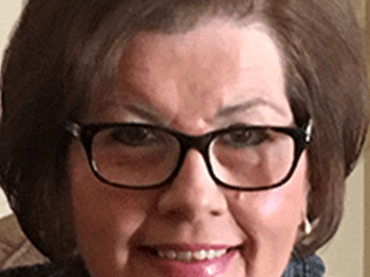The Challenge
Nancy Fawcett, a nurse by trade, spends a lot of time on her feet due to the nature of her job. It’s how a blister formed on the bottom of her left foot that, over time, progressed to a stage 3 nonhealing wound.
“I have neuropathy on my feet,” Nancy explains, which is a result of her diabetes.
Diabetic complications such as neuropathy, caused by damaged nerves, can aggravate foot ulcers and infections and lead to numbness.
“I didn’t feel the blister forming,” says Nancy.
When Nancy finally realized she had a problem, she went to a local wound care center for help. But, after 14 months of treatment, she saw no improvement.
“The wound wasn’t painful,” Nancy says. “But it was taking a long time to heal.”
It also affected Nancy’s ability to do her job. Not only did she have trouble walking, she often couldn’t work at all. She had to stay off her feet to decrease the pressure on her wound and avoid infection.
Though her husband and son were hugely supportive, Nancy wanted to get back to working full time. But, to do so, she knew she had to find another solution.
The Path to UPMC Wound Healing Services
The solution came in an unexpected place: the checkout line of a grocery store. A woman approached Nancy and asked about the boot Nancy wore on her left foot to relieve pressure.
Nancy opened up to this stranger about her nonhealing wound. The woman suggested UPMC McKeesport Wound Healing Services.
Nancy called the next day and booked an appointment with Jessica Sciulli, DPM, who specializes in podiatry and foot and ankle surgery. Dr. Sciulli is one of the many cross-disciplinary experts at UPMC Wound Healing Services.
“The receptionist was a wealth of information, and so kind,” Nancy says. “She gave me hope that I could get healed, which is really nice to hear when you’ve been suffering for 14 months.”
The Solution: Wound Debridement and Vacuum-Assisted Closure
Nancy received a weekly treatment called wound debridement.
Wound debridement involves the removal of infected or nonviable tissue from the site of the wound to speed healing. Once the treatment gets rid of all the infected tissue, doctors can pack and wrap the wound.
Using this method, Nancy’s wound healed in three months under the expert care of Dr. Sciulli.
“Never once did she tell me I wasn’t doing enough on my own. She gave me constructive advice and was always very respectful,” Nancy says.
Sadly, less than a month after her wound healed, Nancy’s father died. After standing for long periods at his funeral, the wound opened back up. Nancy returned to UPMC and was on the path to healing once more when she faced yet another setback — osteomyelitis.
Osteomyelitis is a bone or bone marrow infection, caused by bacteria or other germs. It can occur after an infection spreads from elsewhere in the body. In Nancy’s case, the infection spread quickly over her foot.
Dr. Sciulli was on vacation, so Nancy went to the Emergency Department at UPMC East for treatment. There, she came under the care of Jeffrey Manway, DPM, who often works with Dr. Sciulli on nonhealing wounds.
After consulting over the phone, Drs. Sciulli and Manway chose to remove the top layer of skin from Nancy's foot. This would get rid of the infected tissue. They then determined that they needed to amputate Nancy’s pinkie toe to save the rest of her foot.
After Dr. Sciulli got back from vacation, she set Nancy up with UPMC home care nurses to provide vacuum-assisted closure.
In advanced wound healing, vacuum-assisted closure helps drain blood or fluid from a nonhealing wound.
Nurses insert a special piece of foam attached to a suction tube into the wound, then cover and seal it with adhesive. Next, they connect the tube to a pump to drain the wound and create a partial vacuum.
This treatment can reduce the size of the wound, help prevent infection, and increase blood flow to the area to speed recovery.
After three weeks of vacuum-assisted closure, Nancy’s wound started to close. She followed up with Dr. Sciulli for wound debridement and wrapping. Three months after opening back up, Nancy’s wound healed again.
The Results: Back on Her Feet
Now, Nancy is back to normal — just missing a pinkie toe, she jokes. While she has some balance issues because of the missing toe, she’s learning to walk without it. She’s eager to return to working full time and living her life, surrounded by a great network of friends and family.
“She not only did it once but twice!” Nancy says, referring to Dr. Sciulli’s ability to mend her hard-to-heal wound. “Everybody at UPMC treated me with respect, kindness, and interest. It was a great experience.”
If you or a loved one suffer from a nonhealing wound, call 844-639-4712 for an appointment at a wound center near you.

















